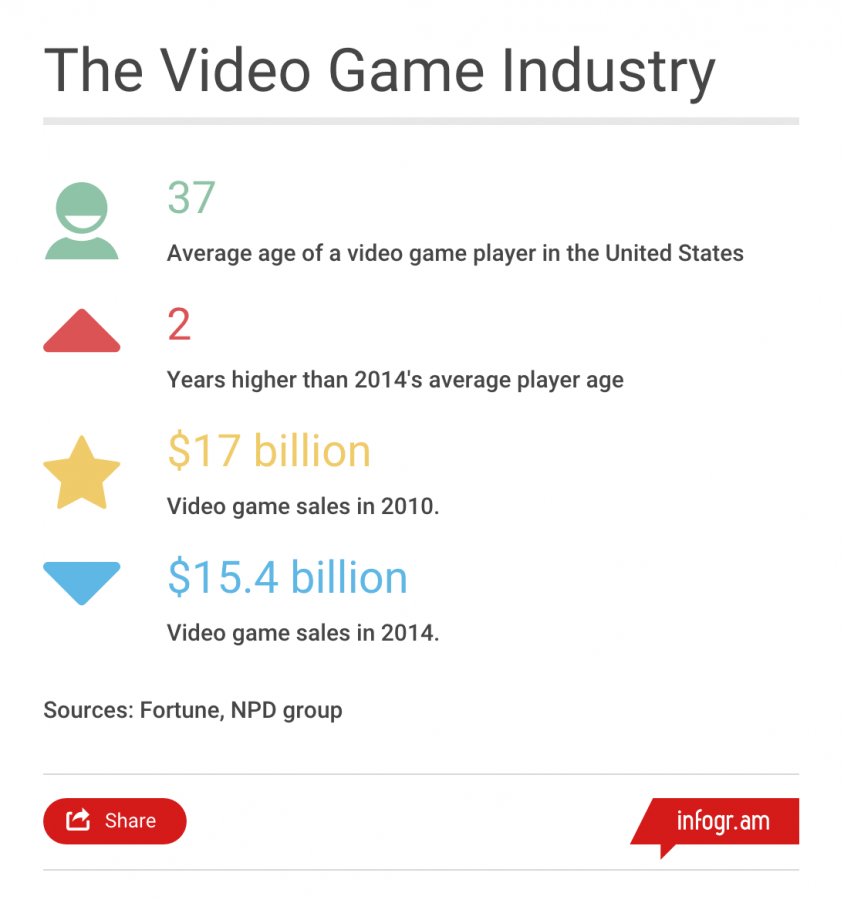Wingspan Extended: Virtual reality technology extends the video game industry
November 12, 2015
A black, box-shaped, plastic headset with stretchy black straps sits on a wooden table. A few students linger around. One steps up to the table. She fits the straps onto her head.
The image of a stadium is projected inside the Oculus headset, and as the user turns around slowly, the image extends like a panorama, creating a 3-dimensional immersive experience.
Virtual reality technology like that presented at the 3D-4U booth at the 2015 TEDxHarkerSchool event is beginning to make a splash in the film world. One example is The New York Times’s documentary “The Displaced,” a project that depicts the lives of three children displaced from their former homes.
Another potential arena for virtual reality technology is video games, an industry which some believe would be revolutionized by a 3-dimensional experience.
“I think it would dramatically change the idea of video games, because virtual reality would provide a more interesting or immersive experience for gamers and broaden the possibilities for video games,” Alexander Young (9) said.
According to Fortune, Lions Gate Entertainment is developing a virtual reality shooter game. According to Daily Mail, Utah virtual reality company The Void has created an a game in which players wear a headset, walk around a warehouse and are able to see themselves in the actual game.
Gwyneth Chen (10) attended TEDxHarkerSchool and tried on a virtual reality headset.
“It was interesting because the part when you turned your head and the pictures moved around — that was working, but unfortunately it was very fuzzy,” she said. “It was interesting but not really polished.”
Sophomore Amy Dunphy also commented on the quality of virtual reality headsets. Shas tried out Google Cardboard, a virtual reality platform that consumers can create themselves based off of online schematics.
“You turn your head and it moves around with you, and it’s fairly good. If you turn your head too quickly, it’ll glitch out, but if you go slowly enough, it’ll be like it’s reality,” she said.
The MIT Technology Review cites the reason for Carboard’s lag as the fact that it uses smartphones, which can’t always update images fast enough to match the rate the user turns.
According to The Economist, virtual reality works by detecting the user’s rotation and replacing the previously displayed one with a slightly different one, designed to reflect the degree to which the user turned. This essentially gives the wearer a sense of seeing and being inside a 360-degree, continuous scene.
“I think if people wanted it enough and they made it actually look as nice as the [2-dimensional] stuff they have now, it has the potential to become a very popular medium just because [of] the whole immersion feeling of it,” Gwyneth said.
As more virtual reality technologies develop, immersion technology is being used more often to redefine video games.
Wingspan Extended: Our longform magazine publication Wingspan has explored many topics from sports controversies to the gender gap. All Wingspan Extended articles, this serves as a continuation and update for the complex issues delved into in Wingspan. This article is intended to extend a topic brought up in Wingspan’s first issue in the article Game On, which discussed e-sports and the culture of gaming.


















![“[Building nerf blasters] became this outlet of creativity for me that hasn't been matched by anything else. The process [of] making a build complete to your desire is such a painstakingly difficult process, but I've had to learn from [the skills needed from] soldering to proper painting. There's so many different options for everything, if you think about it, it exists. The best part is [that] if it doesn't exist, you can build it yourself," Ishaan Parate said.](https://harkeraquila.com/wp-content/uploads/2022/08/DSC_8149-900x604.jpg)




![“When I came into high school, I was ready to be a follower. But DECA was a game changer for me. It helped me overcome my fear of public speaking, and it's played such a major role in who I've become today. To be able to successfully lead a chapter of 150 students, an officer team and be one of the upperclassmen I once really admired is something I'm [really] proud of,” Anvitha Tummala ('21) said.](https://harkeraquila.com/wp-content/uploads/2021/07/Screen-Shot-2021-07-25-at-9.50.05-AM-900x594.png)







![“I think getting up in the morning and having a sense of purpose [is exciting]. I think without a certain amount of drive, life is kind of obsolete and mundane, and I think having that every single day is what makes each day unique and kind of makes life exciting,” Neymika Jain (12) said.](https://harkeraquila.com/wp-content/uploads/2017/06/Screen-Shot-2017-06-03-at-4.54.16-PM.png)








![“My slogan is ‘slow feet, don’t eat, and I’m hungry.’ You need to run fast to get where you are–you aren't going to get those championships if you aren't fast,” Angel Cervantes (12) said. “I want to do well in school on my tests and in track and win championships for my team. I live by that, [and] I can do that anywhere: in the classroom or on the field.”](https://harkeraquila.com/wp-content/uploads/2018/06/DSC5146-900x601.jpg)
![“[Volleyball has] taught me how to fall correctly, and another thing it taught is that you don’t have to be the best at something to be good at it. If you just hit the ball in a smart way, then it still scores points and you’re good at it. You could be a background player and still make a much bigger impact on the team than you would think,” Anya Gert (’20) said.](https://harkeraquila.com/wp-content/uploads/2020/06/AnnaGert_JinTuan_HoHPhotoEdited-600x900.jpeg)

![“I'm not nearly there yet, but [my confidence has] definitely been getting better since I was pretty shy and timid coming into Harker my freshman year. I know that there's a lot of people that are really confident in what they do, and I really admire them. Everyone's so driven and that has really pushed me to kind of try to find my own place in high school and be more confident,” Alyssa Huang (’20) said.](https://harkeraquila.com/wp-content/uploads/2020/06/AlyssaHuang_EmilyChen_HoHPhoto-900x749.jpeg)







